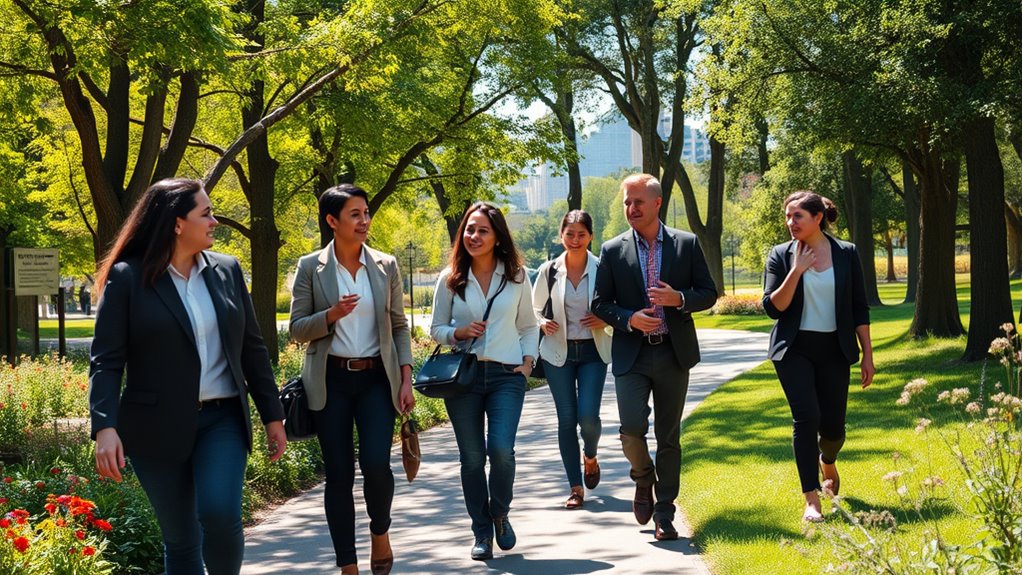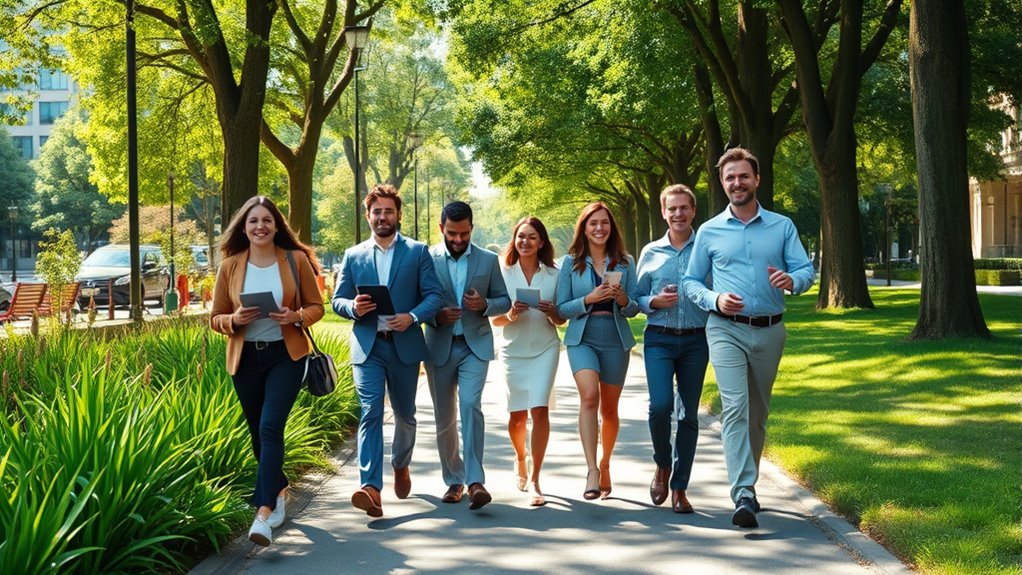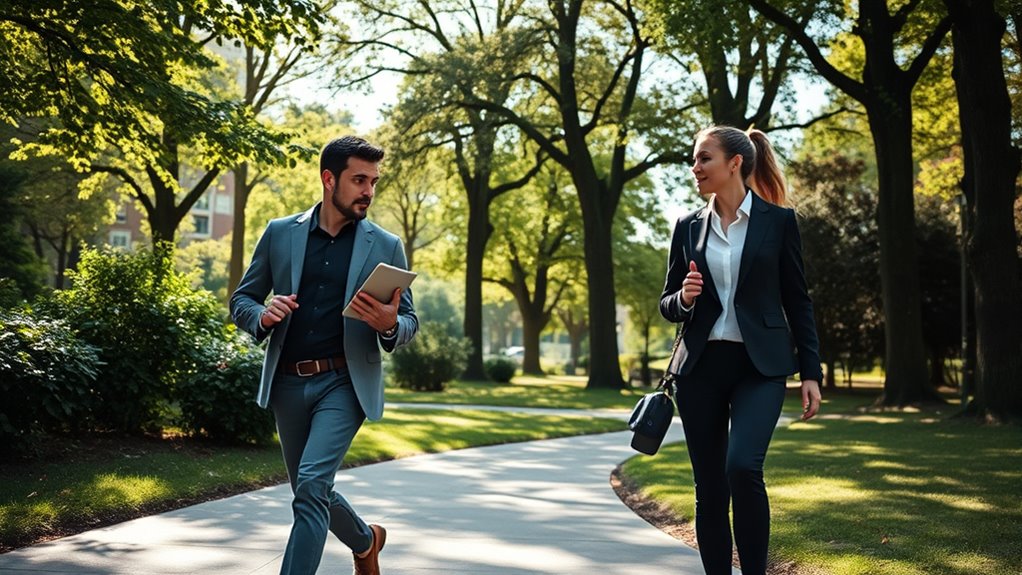Walking meetings can boost your productivity and improve your health by combining movement with discussion. They boost creativity, help clear your mind, and reduce sedentary time, leading to better focus and mental clarity. Organizations are adopting them to promote wellness and sustainability, while choosing scenic, accessible routes guarantees comfort and inclusivity. Addressing potential challenges with tech tools makes these meetings more effective. Keep exploring how to make walking meetings work for you and your team.
Key Takeaways
- Walking meetings enhance creativity, focus, and mental clarity by integrating physical activity into daily routines.
- They promote physical and mental health benefits, reducing sedentary behavior and boosting mood.
- Proper planning, route selection, and clear objectives improve the effectiveness of walking meetings.
- Urban planning trends support walkability, contributing to organizational sustainability and employee well-being.
- Technology tools like GPS, apps, and wearables can facilitate and optimize walking meeting experiences.
The Rise of Walking Meetings in Modern Workspaces

As workplaces seek innovative ways to boost productivity and employee well-being, walking meetings have gained popularity in modern workspaces. This trend reflects a shift influenced by urban planning efforts that prioritize walkability and outdoor access, making walking meetings more feasible. Additionally, organizations are increasingly aware of the environmental impact of traditional office routines, recognizing that encouraging movement reduces reliance on cars and minimizes carbon footprints. Walking meetings promote a more sustainable approach to work by integrating physical activity into daily routines. Moreover, implementing vertical storage solutions and creating designated zones can support the transition to more active and flexible work environments. As companies adopt these practices, they align with broader urban planning goals aimed at creating healthier, more connected communities. This movement not only benefits individual health but also supports environmental sustainability, making walking meetings a timely response to modern societal needs. Incorporating physical activity into daily work routines can also enhance employee focus and creativity, further boosting overall productivity. Emphasizing employee wellness initiatives is essential for fostering a healthier and more engaged workforce. Additionally, integrating well-designed walking routes within office layouts can encourage spontaneous movement and reduce sedentary behavior among employees.
Benefits of Incorporating Walking Meetings Into Your Routine

Incorporating walking meetings can boost your physical activity without extra effort, helping you stay healthier throughout the day. As you walk, you’ll find your ideas flow more freely, sparking creative solutions. Plus, stepping outside can clear your mind, making it easier to focus and think more clearly.
Enhances Physical Activity Levels
Walking meetings regularly boost your physical activity levels, making it easier to stay active during busy workdays. By choosing suitable routes and wearing ergonomic footwear, you can walk comfortably and avoid fatigue. Incorporate short, frequent walks into your schedule to maximize movement without disrupting your workflow. Proper route planning helps you find scenic or safe paths, making the experience more enjoyable. Using supportive footwear can enhance comfort and reduce the risk of discomfort during walks. These simple adjustments encourage more movement, helping you stay fit and energized while tackling your daily tasks. Incorporating glycolic acid into your skincare routine can also improve skin texture and appearance, making you feel more confident during your active moments. Embracing automation technologies in your routine can further streamline your day, giving you more time to focus on health and productivity. Exploring virtual hackathons can provide additional opportunities to connect and innovate, even from a distance. Walking meetings become a natural way to boost activity levels without extra effort.
Stimulates Creative Thinking
Taking your meetings outdoors can substantially boost your creativity. Walking stimulates your mind, making it easier to generate new ideas during brainstorming sessions. As you stroll, your brain enters a more relaxed state, which encourages free-flowing thinking and novel connections. This environment is ideal for mind mapping, where ideas build upon each other organically. The physical activity helps break mental blocks, enabling you to approach problems from fresh perspectives. Additionally, fetal movements during pregnancy can be felt around 18-20 weeks, highlighting how movement influences bodily awareness and mental states. Movement has long been associated with natural materials, which can further enhance the calming and inspiring atmosphere of your outdoor meetings. Instead of feeling confined in a meeting room, walking allows your thoughts to wander and evolve naturally. You might find that solutions come more easily when you’re in motion, and your team can collaborate more dynamically. Incorporating walking meetings creates a space for creative sparks to fly, enhancing your overall problem-solving abilities. Additionally, sound vibrations from your environment may influence brainwave patterns, further supporting creative thinking.
Improves Mental Clarity
When you step outside for a walking meeting, your mind clears more quickly than it does in a static environment. Walking stimulates your brain, helping you think more clearly and focus better. Incorporating mindfulness exercises during your walk can enhance mental clarity and reduce stress. The physical activity boosts your mental health benefits, making it easier to process information and solve problems. As you walk, you create space for new ideas to emerge and clear mental fog. Plus, the natural surroundings can calm your mind, sharpening your thinking. Engaging in physical activity during these meetings can promote better overall mood and emotional well-being, supported by the positive associations with mindfulness practices.
How Walking Meetings Enhance Creativity and Problem-Solving

Because movement stimulates the brain, walking meetings can considerably boost your creativity and problem-solving abilities. When you walk and talk, your mind becomes more open to new ideas through activities like mind mapping and visual brainstorming. The relaxed environment reduces mental blocks, encouraging free-flowing thoughts and innovative solutions. As you move, your brain forms new connections, making it easier to see problems from different angles. Walking also promotes a more dynamic exchange of ideas, where sketches or diagrams can be quickly sketched on the go, enhancing clarity. This active setting helps break the routine of sitting, inspiring fresh perspectives and fostering collaborative thinking. Incorporating ergonomic movement into your routine can further enhance cognitive benefits. Additionally, engaging in physical activity during meetings can improve overall mental health and reduce stress. Being aware of retail hours can help you plan these active meetings around your schedule, ensuring productivity without conflicts. Recognizing the importance of sustainable habits can encourage the integration of walking meetings into daily routines, promoting long-term health benefits. Overall, walking meetings create the perfect environment for spontaneous creativity and effective problem-solving.
Tips for Organizing Effective and Inclusive Walking Meetings

To run effective and inclusive walking meetings, start by setting clear objectives so everyone stays focused. Choose accessible routes that everyone can comfortably navigate, and encourage all participants to share their ideas equally. By planning thoughtfully, you’ll create a productive and welcoming environment for everyone involved. Incorporating best practices for meetings can further improve engagement and outcomes. Paying attention to individual developmental needs can help ensure all participants feel comfortable and included during the walk. Additionally, considering the best soil for plants can inform outdoor route choices that are both comfortable and safe for all attendees. Selecting a route with good footing helps prevent slips and falls, ensuring safety throughout the walk.
Set Clear Objectives
How can you assure your walking meeting stays focused and productive? The key is to set clear objectives upfront. Well-defined goals guide the discussion and ensure everyone stays on track. Use effective communication strategies to outline what you want to achieve before stepping out. Clarify topics, expected outcomes, and timeframes to prevent drifting off course. To make this easier:
- Write down specific goals beforehand
- Share the agenda with participants in advance
- Reinforce objectives during the meeting to keep everyone aligned
- Incorporate Fokos guidelines to enhance user control over shared information and ensure compliance with privacy preferences. Additionally, understanding narcissistic traits can help identify potential challenges in group dynamics and facilitate better management of interpersonal interactions during meetings.
Choose Accessible Routes
Choosing the right route is essential to keeping your walking meeting focused and inclusive. Opt for accessible routes that accommodate various mobility options, ensuring everyone can participate comfortably. Look for paths with smooth, even surfaces free of obstacles, cracks, or steep inclines. Avoid routes that may be crowded or noisy, which can distract from your discussion. Consider sidewalks, parks, or designated walking trails that offer shade and benches nearby if needed. It’s helpful to scout the route beforehand or select well-maintained, familiar paths. By prioritizing accessible routes, you create an environment where all participants, regardless of mobility levels, feel comfortable and engaged. This thoughtful planning fosters a more inclusive and effective walking meeting.
Encourage Equal Participation
Ensuring all participants have an equal voice during your walking meeting is key to its success. When everyone feels heard, participation becomes more balanced, fostering better collaboration. To encourage equal voice and balanced participation, try these tips:
- Pause periodically to invite input from quieter team members.
- Use open-ended questions to spark conversation and ensure diverse perspectives.
- Keep the pace steady to give everyone time to contribute without feeling rushed.
Addressing Challenges and Limitations of Walking Meetings

While walking meetings offer numerous benefits, they also come with specific challenges that can hinder their effectiveness. Time constraints may limit how long you can hold these meetings, especially if participants have tight schedules or urgent deadlines. Additionally, safety concerns can arise, particularly if the walking route isn’t properly planned or if traffic and environmental hazards aren’t considered. Noise and distractions from the surroundings can also make it difficult to focus and communicate clearly. You might find that certain topics are harder to discuss while walking, especially complex or sensitive issues. Recognizing these limitations helps you plan better, such as choosing safe, quiet routes and scheduling walk meetings when time allows, so you can maximize their advantages without compromising safety or productivity.
Technology and Tools to Support Walking Meetings

How can technology enhance the effectiveness of walking meetings? Wearable devices and mobile apps can help you stay organized, track your activity, and guarantee clear communication. Wearables like fitness trackers monitor your steps and health metrics, encouraging movement and wellness. Mobile apps facilitate scheduling, note-taking, and recording key points during your walk, so nothing gets overlooked. These tools also enable you to share updates instantly, keeping everyone on the same page. Plus, GPS features in apps can map your route, making it easier to plan scenic, engaging walks. Using these technologies, you can maximize productivity without sacrificing health benefits. They make walking meetings more structured, efficient, and enjoyable, ensuring you stay connected and focused while on the move.
Success Stories: Companies Embracing Walking Meetings

Many forward-thinking companies have recognized the benefits of walking meetings and are actively incorporating them into their daily routines. For example, tech firms and creative agencies have seen improvements in office ergonomics, reducing discomfort associated with prolonged sitting. These companies encourage employees to step outside or walk through office hallways for discussions, fostering a more dynamic environment. Some have even integrated walking meetings into virtual collaboration setups by using mobile devices or smart wearables, allowing remote teams to stay engaged while moving. These success stories demonstrate that walking meetings boost productivity, enhance team bonding, and promote healthier habits. As more organizations embrace this approach, you’ll find it easier to break free from traditional conference rooms and create more engaging, health-conscious work routines.
Future Trends: Making Walking Meetings a Standard Practice

As awareness of the benefits of walking meetings grows, more organizations are likely to make them a standard part of their workplace culture. This shift can boost employee engagement, making meetings more dynamic and collaborative. Companies embracing this trend also promote environmental sustainability by reducing reliance on conference rooms and electronics. To make walking meetings mainstream, expect advancements like dedicated outdoor spaces and integrated tech tools to facilitate seamless communication. Organizations may also adopt policies encouraging regular walking breaks, fostering healthier habits. The future holds a movement toward flexible, eco-friendly work practices that strengthen team bonds and support well-being. As this trend gains momentum, you’ll see walking meetings become a key strategy for a more sustainable, engaged, and healthy workplace environment.
Frequently Asked Questions
How Do Walking Meetings Impact Employee Privacy and Confidentiality?
You might worry about privacy concerns and confidentiality protocols during walking meetings. As you walk and talk, sensitive information could be overheard or accidentally shared, risking privacy breaches. To minimize these issues, you should establish clear guidelines, such as choosing quiet, private locations and avoiding discussions of confidential topics. By being mindful of your environment and adhering to confidentiality protocols, you can guarantee that walking meetings remain productive without compromising privacy.
Are Walking Meetings Suitable for All Types of Work and Team Sizes?
You might think walking meetings fit all work types and team sizes, but surprisingly, they don’t. If your team has mobility limitations or handles confidential info, indoor alternatives become essential. While small teams thrive outdoors, larger groups struggle to coordinate without chaos. Ironically, what boosts productivity for some can hinder others. So, consider your team’s unique needs before hopping on the walking meeting bandwagon—it’s not a one-size-fits-all solution.
What Safety Precautions Should Be Taken During Outdoor Walking Meetings?
During outdoor walking meetings, you should prioritize safety by staying aware of traffic safety and choosing safe walking routes. Check the weather forecast beforehand and dress appropriately to prevent slips or heat exhaustion. Carry essentials like water and a mobile phone for emergencies. Stick to well-lit, populated paths, and avoid busy streets. Being prepared helps you stay safe and focused, ensuring your walking meeting remains productive and enjoyable.
How Can Managers Encourage Participation in Walking Meetings?
You can’t just ask your team to join walking meetings and expect everyone to jump in—people need motivation! Use participation incentives like reward programs or recognition to make it irresistible. Offer incentives that truly matter, like extra break time or small gifts. By creating appealing incentive programs and highlighting the health and productivity benefits, you’ll encourage more team members to embrace walking meetings and enjoy the perks.
What Are the Environmental Considerations for Organizing Walking Meetings?
When organizing walking meetings, you should consider sustainable transportation options like nearby parks or safe walking routes to reduce environmental impact. Choose outdoor locations with minimal outdoor pollution to guarantee a healthy experience for everyone. Avoid busy streets with heavy traffic or areas with poor air quality. By selecting eco-friendly routes and clean environments, you promote both health and sustainability, making your meetings more effective and environmentally responsible.
Conclusion
So, next time you’re stuck in a dull meeting, just lace up your sneakers and pretend you’re on a mission to find the lost city of productivity. Who knew that walking could turn your snooze-fest into a creative adventure? Embrace the future where your boss suggests a stroll instead of a PowerPoint marathon. After all, why sit in a stale conference room when you can wander your way to better ideas?










